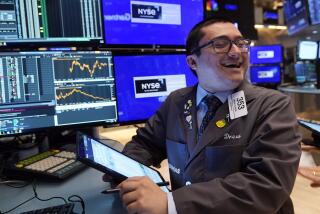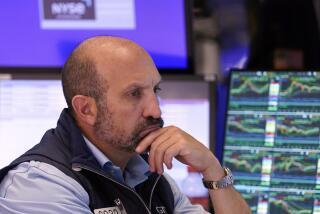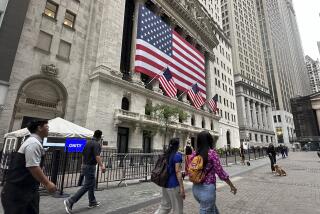Dollar Plummets 2.5% as Major Central Banks Flood Currency Markets : Economic Allies Take Dramatic United Action to Correct Trade Imbalance
WASHINGTON — A new round of massive intervention by major central banks sent the dollar plunging on the world’s foreign exchange markets Monday, providing initial success for the latest effort by the United States and its economic allies to blunt the dollar’s rise.
Plainly seeking to get their point across, the central banks of the United States and some dozen other nations sold massive amounts of dollars in currency markets around the globe, obviously acting in concert to drive the value of the dollar down from its Friday highs.
For the record:
12:00 a.m. Sept. 27, 1989 FOR THE RECORD
Los Angeles Times Wednesday September 27, 1989 Home Edition Business Part 4 Page 2 Column 3 Financial Desk 1 inches; 19 words Type of Material: Correction
Sinking Dollar--A chart of foreign currencies in Tuesday’s editions was mistitled. The correct title should be “The Sagging Dollar.”
By mid-afternoon New York time, the U.S. currency had plummeted a staggering 2.5% from its closing levels on Friday, hitting 1.89 West German marks and 142.10 Japanese yen. It edged up again slightly at the end of the trading day.
But while traders clearly were impressed by both the size and the scope of the central banks’ dollar-selling spree, they said it remains to be seen whether the dollar will remain at Monday’s new levels or will start rising again despite the central bankers’ wishes.
The concerted intervention by the central banks was designed to underscore a warning issued by finance ministers of the Group of Seven--the seven largest industrial democracies--on Saturday declaring that the dollar had risen too far and was threatening to damage the world economy.
The group declared in a formal communique that the dollar’s steady climb in recent months had been “inconsistent with longer-run economic fundamentals.” The group pledged to “cooperate closely” in the markets to help prevent a further rise.
Trade Deficit Issue
U.S. officials have said they are afraid that if the dollar’s value increases much further, it could make U.S. exports less competitive and increase demand for imports, thereby eroding the gains that America has made in trimming the trade deficit. The other finance ministers have agreed.
Stephen H. Axilrod, a one-time senior Fed official who now is vice chairman of Nikko Securities in New York, said the fact that the seven governments followed up their communique with action “tells you they have the resolve; but it’s not an easy situation.”
“The question obviously is going to be whether, once the markets move up again, they (the central banks) can bat it back down as they have before. The real test then will be whether they will get Europe and Japan to raise their interest rates. It’s pretty tough.”
Nevertheless, the finance ministers and central bankers of the Group of Seven--in Washington for the annual meeting of the International Monetary Fund this week--declared their first-day effort an unqualified success.
Karl Otto Poehl, president of the Bundesbank, West Germany’s central bank, said the plunge was “in line with” the ministers’ intentions when they issued their communique. Besides the United States, the Group of Seven includes West Germany, Japan, Britain, France, Italy and Canada.
French Finance Minister Pierre Beregovoy boasted that the market’s reaction on Monday showed that the finance ministers had regained their credibility. “You saw what happened,” he said. “The statement meant what it said.”
Serious Resolve
The wave of intervention by the central banks began early Monday morning in the currency markets of Australia, at the start of a 24-hour trading day that circles the globe continuously via Tokyo, Frankfurt, Zurich, London, New York, Chicago and San Francisco.
In an unusual move, the New York Federal Reserve Bank, which handles currency transactions on behalf of the United States, intervened directly in the exchange markets in Tokyo. It was another effort to underscore the seriousness of the G-7’s resolve.
But traders were still skeptical that intervening in the markets alone would be sufficient to ward off any further rise in the dollar.
Analysts say the dollar has been rising for several reasons, among them sharply higher interest rates and lower inflation rates in the United States, political problems in West Germany and Japan and perceptions of America as a “safe haven” for investments.
On Saturday, the 152-country IMF joined dozens of private analysts who have been predicting that the U.S. trade picture will worsen in the next few years after having improved since the trade deficit peaked in 1986.
Although the language that the finance ministers used was stronger than that used in their last public communique in April, Saturday’s document gave no hint of any new measures or policy changes beyond intervention.
Interest Rates
Contrary to hopes by some U.S. strategists, the ministers apparently rejected any notion that the seven seek to reverse the dollar’s rise by changing interest-rate levels in each of the major countries--a move designed to ease demand for dollars and drive down their value.
Such a plan would have involved increases in interest rates in West Germany and Japan and possibly a simultaneous drop in interest rates in the United States. But while Japan reportedly agreed to go along, West Germany demurred and the Federal Reserve Board declined.
Besides the United States, the intervention effort Monday was joined by the central banks of, among others, Japan, West Germany, Britain, France, Italy and Canada, traders reported. They said the Fed entered the markets a second time, in mid-afternoon.
In separate action, the IMF’s policy-making Interim Committee decided to shelve a request by the organization’s management for a doubling of the institution’s overall lending resources.
Dutch Finance Minister H. Onno Ruding, the panel’s chairman, predicted that the IMF eventually would win an increase of between 50% and 67% of its current lending pool, but not until at least 1990. The IMF’s resources now total $120 billion.
At the same time, the panel approved new punitive measures designed to crack down on developing countries that have refused to keep up their payments on IMF loans. Under the new rules, the fund may deny new resources to those countries and eventually expel them.
More to Read
Inside the business of entertainment
The Wide Shot brings you news, analysis and insights on everything from streaming wars to production — and what it all means for the future.
You may occasionally receive promotional content from the Los Angeles Times.










